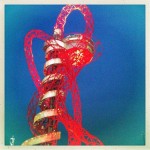Whiplash – you hear the term used all the time but do you really know what it is and why it occurs? Here it is for you, put simply by Danny Adams, Chiropractor at Longlevens Chiropractic & Sports Injury Clinic:
Studies show that a rear-end collision of as slow as 5 Mph can result in what is known as a “Whiplash Associated Disorder” (WAD). (This is the correct term for whiplash used by medical professionals). Classically, most people will tell you that a rear end car collision is what leads to Whiplash. However, this is not the case, as you can see from the term ‘Whiplash Associated Disorder’ Whiplash can occur in many different ways. If you follow the definition you would be forgiven for thinking that Whiplash can only be as a result of hyper flexion and hyper extension. However, what is more common is that when a person experiences whiplash it is as a result of the person’s neck not being prepared correctly for the rapid change in movement. Whether the impact to the persons body came from behind or the sides. This is because the muscles of the neck are not prepared correctly to brace the neck bones and tissue (usually because the person was not expecting to injure themselves). Then by the time they have braced it is too late and the damage has been done. Also, mistakes are made in treating, where it is commonly thought that the ligaments surrounding the facet joints (little joints that connect each segment of the spine) get sprained due to hyperflexion (too much flexion) and subsequent hyperextension (too much extension) whereas, in fact, a large amount of joint compression occurs as the neck gets taken through and ‘S’ shape curve just after impact seen in the middle picture below.

Here is the classification of WAD injuries just to show you how different each Whiplash injury can be. There are a few different classifications though this one is most common at the moment, designed by ‘The Quebec Task force”. If you have suffered Whiplash then you would have fallen in to one of these graded categories.

Now, another very common mistake to make with Whiplash is that the injury only occurs within the bony part of the neck and local tissues. In fact a large part, if not the majority of your pain will be coming from the surrounding musculature that braced the neck too late. What happens is that the muscles that failed to respond quickly enough at the time of impact are kept in a state of neurologically controlled hypertension (too tight!) as they form their own protective brace around the bones and tissue of the neck. Don’t get me wrong, there may have been bone, joint and tissue damage but it is usually the muscles that are responsible for the long term effects of Whiplash. Often the segments of the spine, their joints and local tissue have often healed while the muscles can stay in a state of unnecessary tightness for years after.

A simple but frustrating mistake I hear time and time again when advice is given for Whiplash is “use heat to relieve the pain and symptoms”. For the life of me I do not know why this is suggested, if you get a bruise or you tear/strain a muscle why would you want to encourage the inflammation with heat in the early stages? Heat feeds inflammation, if you read the physiology behind inflammation you will see that inflammation is a genius evolutionary process but essentially quite crude. The body does a great job with inflammation breaking down and clearing out dead and diseased tissue, though it often goes too far and can in fact damage it’s own healthy cells, thus prolonging the recovery of an injury. By applying heat you will get relief at the time of application due to the over riding of the ‘pain gate’ at the damaged region. However, a few hours later the pain often will return and sometimes it can be worse. I’d suggest using ICE 10-15 minutes every 2 hours and observe the difference.
If you would like further information on whiplash please contact us on 01452309372 or email contact@longlevenschiro.com. See more of Danny’s articles here.







